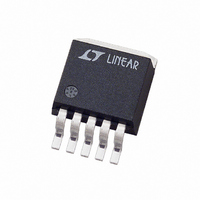LT3080EQ#TRPBF Linear Technology, LT3080EQ#TRPBF Datasheet - Page 11

LT3080EQ#TRPBF
Manufacturer Part Number
LT3080EQ#TRPBF
Description
IC REG LDO ADJ 1.1A 5-DDPAK
Manufacturer
Linear Technology
Datasheet
1.LT3080ESTTRPBF.pdf
(26 pages)
Specifications of LT3080EQ#TRPBF
Regulator Topology
Positive Adjustable
Voltage - Output
0 ~ 36 V
Voltage - Input
1.2 ~ 36 V
Voltage - Dropout (typical)
1.35V @ 1.1A
Number Of Regulators
1
Current - Output
1.1A
Current - Limit (min)
1.1A
Operating Temperature
-40°C ~ 125°C
Mounting Type
Surface Mount
Package / Case
TO-263-5, D²Pak (5 leads + Tab), TO-263BA
Lead Free Status / RoHS Status
Lead free / RoHS Compliant
Available stocks
Company
Part Number
Manufacturer
Quantity
Price
(5 milliohms for the two devices in parallel) only adds about
10 millivolts of output regulation drop at an output of 2A.
Even with an output voltage as low as 1V, this only adds
1% to the regulation. Of course, more than two LT3080’s
can be paralleled for even higher output current. They are
spread out on the PC board, spreading the heat. Input
resistors can further spread the heat if the input-to-output
difference is high.
Thermal Performance
In this example, two LT3080 3mm × 3mm DFN devices
are mounted on a 1oz copper 4-layer PC board. They are
placed approximately 1.5 inches apart and the board is
mounted vertically for convection cooling. Two tests were
set up to measure the cooling performance and current
sharing of these devices.
The fi rst test was done with approximately 0.7V input-
to-output and 1A per device. This gave a 700 milliwatt
dissipation in each device and a 2A output current. The
temperature rise above ambient is approximately 28°C
and both devices were within plus or minus 1°C. Both the
thermal and electrical sharing of these devices is excel-
lent. The thermograph in Figure 5 shows the temperature
distribution between these devices and the PC board
reaches ambient temperature within about a half an inch
from the devices.
The power is then increased with 1.7V across each device.
This gives 1.7 watts dissipation in each device and a device
APPLICATIONS INFORMATION
Figure 5. Temperature Rise at 700mW Dissipation
temperature of about 90°C, about 65°C above ambient
as shown in Figure 6. Again, the temperature matching
between the devices is within 2°C, showing excellent
tracking between the devices. The board temperature has
reached approximately 40°C within about 0.75 inches of
each device.
While 90°C is an acceptable operating temperature for these
devices, this is in 25°C ambient. For higher ambients, the
temperature must be controlled to prevent device tempera-
ture from exceeding 125°C. A 3-meter-per-second airfl ow
across the devices will decrease the device temperature
about 20°C providing a margin for higher operating ambi-
ent temperatures.
Both at low power and relatively high power levels de-
vices can be paralleled for higher output current. Current
sharing and thermal sharing is excellent, showing that
acceptable operation can be had while keeping the peak
temperatures below excessive operating temperatures on
a board. This technique allows higher operating current
linear regulation to be used in systems where it could
never be used before.
Quieting the Noise
The LT3080 offers numerous advantages when it comes
to dealing with noise. There are several sources of noise
in a linear regulator. The most critical noise source for any
LDO is the reference; from there, the noise contribution
Figure 6. Temperature Rise at 1.7W Dissipation
LT3080
11
3080fb














